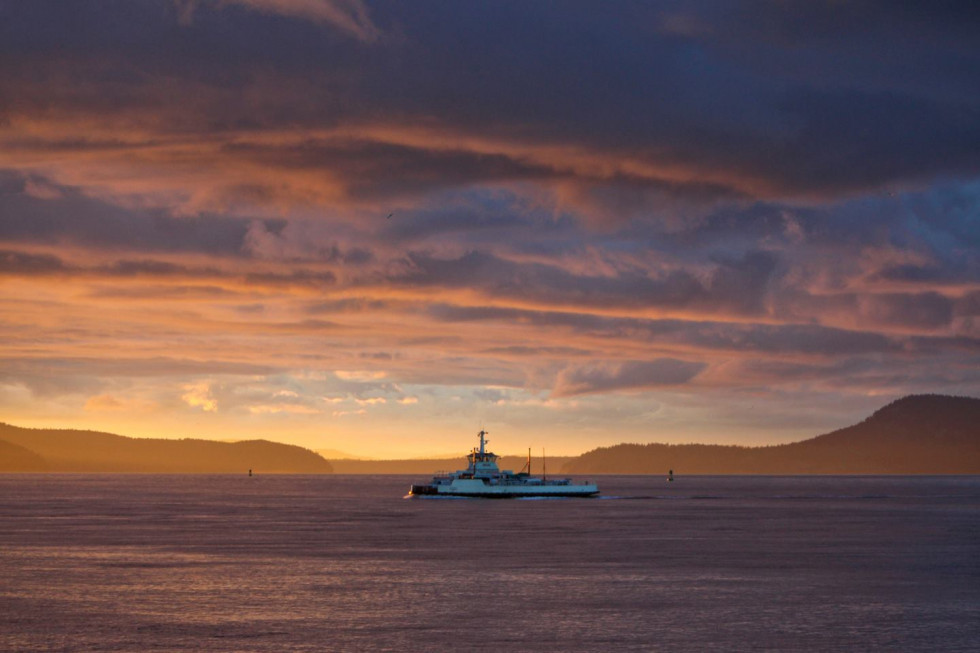By Thaddeus Hink
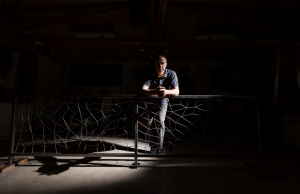 “Do you want tea?”
“Do you want tea?”
“No,” I said, “I just had coffee.”
“Caffeinated or no?”
“Low-caf”
“Low-caf, never heard of that. Do you just mix the two?”
“Yep, half decaf, half regular .”
“That’s medium-caf, but it probably still has more caffeine than tea.”
And as I gaffer tape an umbrella to a light stand Jim says, “$300 and you have to tape it together?”
“Naw, $30 for the umbrella.”
“$30 of course, it’s an umbrella… how much is an umbrella gonna cost… I love umbrellas. They’re a marvel of structural engineering to me. For a light weight thing you get so much…”
And this is how a conversation begins with Jim Lapp.
Jim’s interests in school started with science, though he found himself taking art courses. In the end, without enough credits for a BS or BFA, he received a BA – or as he puts it, “A bachelors of nothing.” He applied to graduate school in both biology and fine art. The biology programs saw him bounced around a lot, whereas the MFA programs said, “Hey, it looks like you have diverse interests.” So MFA it was. Beginning as a painter, Jim switched to sculpture during the program. After school and relocating from Chicago to Washington Jim worked as a machinist and learned to weld in Port Townsend. In becoming an accomplished welder he was able to give a voice to the sculptures he was creating. This created intriguing and sometimes playful sculptures.
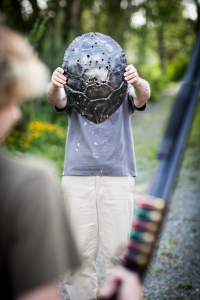 Jim’s work ranges from figurative to abstracts that deal mass and movement. In his piece, “They Shoot Turtles Don’t They” Jim fabricated a steel turtle shell and took it to the local rifle range and asked if anyone would care to shoot at his sculpture. “Part of art is about process. This may be one of the only collaborative pieces I’ve done but they had fun with it.” There was no shortage of people on the range that were willing to shoot up his sculpture. This phase of his figurative work eventually gave way to sculpture as balance and motion. Rocks suspended and balanced, some hanging, some on rotating armatures, motion was a way to communicate balance.
Jim’s work ranges from figurative to abstracts that deal mass and movement. In his piece, “They Shoot Turtles Don’t They” Jim fabricated a steel turtle shell and took it to the local rifle range and asked if anyone would care to shoot at his sculpture. “Part of art is about process. This may be one of the only collaborative pieces I’ve done but they had fun with it.” There was no shortage of people on the range that were willing to shoot up his sculpture. This phase of his figurative work eventually gave way to sculpture as balance and motion. Rocks suspended and balanced, some hanging, some on rotating armatures, motion was a way to communicate balance.
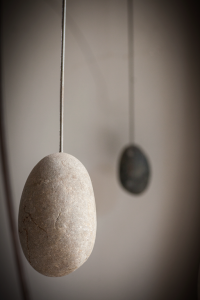 And then there’s music. Influenced by the repetitive nature of music and putting elements in a state of time Jim hung rocks in different intervals in trees referencing the idea of how time and space interact and play off each other. “It really had to do with stuff moving, putting things into time, and music’s about time, about intervals, about silence.” Jim sees music as the purest art form, one that can influence without needing a reference – universal. His spinning pieces strive to convey the same thing.
And then there’s music. Influenced by the repetitive nature of music and putting elements in a state of time Jim hung rocks in different intervals in trees referencing the idea of how time and space interact and play off each other. “It really had to do with stuff moving, putting things into time, and music’s about time, about intervals, about silence.” Jim sees music as the purest art form, one that can influence without needing a reference – universal. His spinning pieces strive to convey the same thing.
There was the move to photography. Not really a move, but a rekindled interest because of the advancement of digital photographic capabilities. Jim learned film and darkroom techniques in Chicago and spent time doing product photography with a large format cameras. A year of that was enough for photography for the time being. As with many of us, digital technology ushered photography back into our artist elements.
A certain piece of piano music comes on the stereo and he goes back to music, “I have no feeling for it [referring to playing an instrument], I’m like the opposite of somebody who has a feel for music. I never have, never had any rhythm, couldn’t dance, none of it, it just went over my head, through my head. It went around me though. That’s why it’s in my head that I wanted to learn to play an instrument [piano]. And even though I suck, I really like it.”
“I tried to play the recorder but the dog didn’t like it. This was a soprano recorder that a roommate gave me back in 1974 in my first year of college, I’ve kept it this whole time thinking someday, someday I’ll learn to play this thing. So I ordered an alto and the dog didn’t cry so much. But I had a lot of trouble with it. Then I started thinking about it, about what instrument could I play? I thought recorder was good because they say it’s the easiest instrument to play. What’s the hardest? Piano. But I’ve always liked the clarity of piano music. And I thought it would be really good for my brain. Working with two hands, reading music, because it seem to be a neat thing to learn this whole new language.”
I questioned how the music manifests itself in the sculpture and how it was manifesting itself in everyday life through the direct experience of learning the piano. We digressed into a conversation about Glen Gould. Then we digressed a little further about John Cage and speculated about if you went out to lunch with Mr Cage you would order nothing. Jim laughs, “There’s food and there’s no food and we’re gonna go with no food and it’s gonna just take two hours not to eat…”
On conceptual music and art, ”That kind of stuff was mentally interesting, but I found with a lot of the [conceptual] music you listen to it’s just a no, it’s just not working. You could mentally get a grip on it but it was like a lot of art back then, when I first saw I was like, that’s not right. But when I started getting interested in art, it was like an intellectual process and I became convinced it was really interesting. But I like some music with my music, just like I like some organization with my art, any art.”
And we come back to photography once more. I ask, “So the digital end let you back into the technical side of photography?”
“There’s something totally clear about a photograph, like some prints, but even more so. When you look at the old guys, partly because of their medium, view cameras and all, but also because of the size and the technical quality was so good. The world could look super hypereal, more complete than real life.”
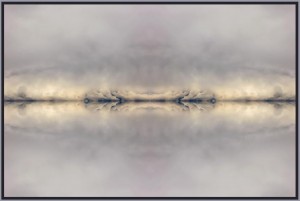 “I started making pictures of water and the reflections in the water. But my real interest was when I started combining and reversing images. It has a real mathematical feel to it.”
“I started making pictures of water and the reflections in the water. But my real interest was when I started combining and reversing images. It has a real mathematical feel to it.”
We then tie in photography to the sculpture, Jim describes the similarities of process. In both cases there is an organic feel along with an element of structure.
“In the photographs, when you flip them, you’re in a new world. I started reading about Bach and what the right hand and left hand were doing. He’d be doing something where the left hand was doing a variation of the right hand, or the opposite. You could propose a mathematical problem and see if you could come up with a solution to it.”
“The flipping is a little different, it’s a mirror image. These started with mirror images, like with faces. In the photographs it’s not about symmetry but about creating a new world, a new way of organizing the world. And there are patterns that aren’t there, they are kind of latent.”
Both Jim’s sculptural and photographic work has been shown widely throughout the region. He has done both installation pieces in Anacortes and participated in the juried Pier show for the Anacortes Arts Festival. In 2013 he received the People’s Choice award for his photography in the Pier show. His work can be found online at http://jameslapp.com/
Article and Photography by Thaddeus Hink – http://thinkstudios.net
